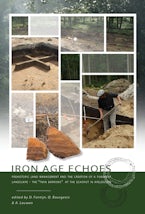David Fontijn (1971-2023) was professor in the Archaeology of Early Europe at the Faculty of Archaeology, University of Leiden, the Netherlands. His research dealt with the early agrarian societies of Europe from prehistory up until the early historical period, with a particular focus on the Bronze and (early) Iron Age, the exchange and deposition of metalwork and the archaeology of so-called ritual landscapes. He led the NWO-VICI project ‘Economies of Destruction’ investigating the puzzling destruction of valuable objects in Bronze Age Europe (2015-).
He graduated and wrote his PhD-thesis at Leiden University, both theses were marked cum laude and both were awarded the W.A. van Es Prize for Dutch Archaeology (1996 and 2003). His book ‘Sacrificial landscapes’ was also awarded the Praemium Erasmianum Study Prize (2003). He had a short-list nomination for best teacher of Leiden University in 2005 and won this LSR Teaching award in 2008. His project ‘Ancestral Mounds’ received the SIKB Prize for best archaeological research team in 2009 and a book resulting from it was received by Her Majesty Queen Beatrix of the Netherlands in 2012. Fontijn was senior research fellow in the excellence cluster ‘TOPOI’ in Berlin, where he worked at the Eurasia Department of the German Archaeological Institute DAI (2009-2010). From 2013-2016, he was director of Research at the Faculty of Archaeology.
Recent books are ‘Living near the dead’ (2010, editor and co-author), ‘Iron Age Echoes’ (co-editor with Q. Bourgeois and A. Louwen and co-author), ‘Transformation Through Destruction’ (co-editor with S. van der Vaart and R. Jansen and co-author), and ‘Beyond Barrows’ (co-editor with A. Louwen, S. van der Vaart, and K. Wentink and co-author). The volume ‘Death Revisited’ (co-editor with A. Louwen and co-author) came out in 2018, and he published an acclaimed book on deposition with Routledge entitled ‘Economies of Destruction’ in 2020. David Fontijn was working on a book offering a new perspective on the Bronze Age when he passed away in 2023.
Quentin performed his PhD study within the research project Ancestral Mounds.In his research he dealt with groups of barrows and their position within the landscape. Through extensive GIS-analyses he attempted to shed some light on the choice of location for the placement of the burial monuments. Why were they placed there, what could be seen from that location, and how did this develop through time?











